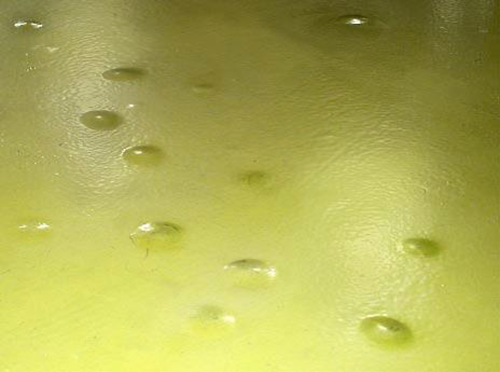 Excess concrete moisture can damage flooring materials, regardless of how well the flooring system is installed. When too much moisture is present in a concrete slab, or when a moisture barrier is not effective, carpeting can get moldy, wood floors can buckle, vinyl floor tiles tend to detach, and floor coatings can bubble and delaminate.
Excess concrete moisture can damage flooring materials, regardless of how well the flooring system is installed. When too much moisture is present in a concrete slab, or when a moisture barrier is not effective, carpeting can get moldy, wood floors can buckle, vinyl floor tiles tend to detach, and floor coatings can bubble and delaminate.
What causes the presence of moisture in a concrete substrate? There are several common sources. Moisture can come from the water used in concrete flooring placement and finishing. Also it can come from water sources below ground, such as high water tables and/or nearby lakes or rivers. This can result in hydrostatic pressure forcing moisture vapor into and upward through the capillaries in the concrete substrate. A higher porosity concrete slab will allow this process to occur more freely. In addition, there is also the possibility that moisture can migrate laterally into the concrete slab from rainwater or irrigation systems.
Moisture vapor pressure can build up to the point where a coating or adhesive that is bonded to concrete slab can exceed the cohesive strength and attack the integrity of the adhesive/coating.
This water/vapor migration process requires time and quantifiable concrete moisture measurements to verify the concrete moisture state.
Two methods are currently used to determine the moisture level of a concrete substrate.
ASTM F1869 –Standard Test Method for Measuring Moisture Vapor Emission Rate of Concrete Subfloor Using Anhydrous Calcium Chloride and ASTM F2170 - Standard Test Method for Determining Relative Humidity in Concrete Floor Slabs Using In-Situ Probes are the two test methods most often used.
If the moisture vapor emission rate, or relative humidity levels exceed specified industry standards then moisture mitigation systems are utilized.
Alkalinity’s Effect
In addition there is also the potential effect of alkalinity on coatings and adhesives. Concrete, by its very nature, is an alkaline product. Osmotic action can lead to high concentrations of moisture and alkalinity, especially at the bond line. This can lead to the deterioration of flooring adhesives and delamination of coatings. Over time, even with relatively low moisture vapor emissions (MVER), elevated alkalinity can compromise even the toughest flooring system coatings/adhesives.
The Solution
Our Moisture Mitigation systems are designed to seal concrete and reduce moisture vapor emissions. They are also formulated/designed to be resistant to high alkaline conditions. Thereby reducing the possibility of damage to flooring materials.
Our Products
Euclid Chemical has two new moisture mitigation primers, DURAL AQUATIGHT WB and DURAL AQUATIGHT 100. The Dural Aquatight WB is a low viscosity, two component, water-based epoxy emulsion primer. The Dural Aquatight 100 is a two component, 100% solids, modified epoxy system.
Both products reduce moisture vapor transmission rates, are resistant to high alkaline conditions, have low to no VOC’s, are low odor, and provide excellent adhesion to properly prepared concrete.
Dural Aquatight WB is used with Euclid Chemical’s decorative, industrial, and traffic deck coating systems. It is NOT to be used with any cementitious underlayment or overlay products.
Dural Aquatight 100 can be used with Euclid Chemical’s decorative, industrial, and traffic deck coating systems as well as under Euclid Chemical's cementitious underlayment products.
For more information on these or other Euclid Chemical products, contact your local sales representative or send us a message through our contact form.
 ABOUT STEVE SCARPINATO
ABOUT STEVE SCARPINATO
Steve has been with The Euclid Chemical Company for the last 12 years. He began his career at Dural International Corporation, a manufacturer of epoxy and cementitious repair products, after graduating from Fordham University. In his current role, Steve is in the Coatings Segment Manager, responsible for Traffic Deck, Architectural Wall, Decorative Floor, Industrial, Waterproofing & Dampproofing Coatings, and Epoxy Grouts.